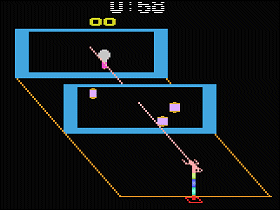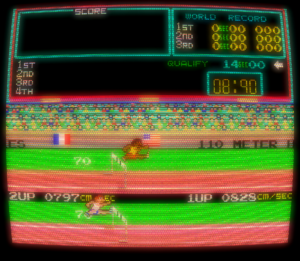 The Game: You’re manning an experimental laser in a shooting gallery, trying to zap objects as they cross a screen at the far end of the room. A direct hit scores points, but the clock is always ticking down and any objects that haven’t been shot down will remain in play until they’re eliminated. At the end of each round, you’ll be tasked with shooting the flame off of a candelabra, though its rapidly melting candles may make this trickier than you think. With each new level, targets get smaller – and rows of floating mirrors threaten to bounce your laser right back at you if you hit them instead of your target. (20th Century Fox, 1983 [never released])
The Game: You’re manning an experimental laser in a shooting gallery, trying to zap objects as they cross a screen at the far end of the room. A direct hit scores points, but the clock is always ticking down and any objects that haven’t been shot down will remain in play until they’re eliminated. At the end of each round, you’ll be tasked with shooting the flame off of a candelabra, though its rapidly melting candles may make this trickier than you think. With each new level, targets get smaller – and rows of floating mirrors threaten to bounce your laser right back at you if you hit them instead of your target. (20th Century Fox, 1983 [never released])
Memories: In video game terms, lasers are like the opposite of the weather – everyone fires them, but nobody ever talks about them. Though Lasercade belongs to the same category as Carnival and Shootin’ Gallery, its 3-D angle on the basic shooting gallery game is unique in the 2600 library, and for the first time, it really plays with the underlying concept and physical reality of firing lasers. Really.
In Lasercade, you’re firing a mounted, mobile laser. Not as in Space Invaders, mind you, but as in an experimental laser in a laboratory. You can adjust the laser’s height on the fly, but there are other considerations. The roving mirrors can mean life and death – draw a bead on their exposed (and presumably non-reflective) backside, and you can blast the mirrors into smithereens (until some helpful soul puts them all back together on  the next level you reach – gee, thanks, lab assistant). Hit the reflective side and your laser’s light and power is headed right back your way, temporarily immobilizing your laser and costing precious time. Prior to this, the most concession we ever got to the reality of laser weapons was that they might overheat or drain the energy banks.
the next level you reach – gee, thanks, lab assistant). Hit the reflective side and your laser’s light and power is headed right back your way, temporarily immobilizing your laser and costing precious time. Prior to this, the most concession we ever got to the reality of laser weapons was that they might overheat or drain the energy banks.
Programmed by Lee Actor for a small company called Videa (which was later gobbled up by Nolan Bushnell’s post-Atari-non-compete-clause startup Sente), Lasercade sadly never saw the light of day, never mind the light from a laser. The game was sold, in a finished state, to 20th Century Fox’s game division, but as the crash was claiming corporate victims left and right, Fox ultimately declined to issue any more games. Videa sold the game to Atari itself…which then proceeded to sit on it without releasing it. The finished game finally appeared at the 2007 Classic Gaming Expo in Las Vegas, where it was available in limited quantities on cartridge in a box that strongly resembled the packaging design used by Fox.
 Though it’s not quite in the stratosphere of truly addictive, compelling games for the Atari 2600, Lasercade isn’t bad, and it was a worthwhile experiment in bringing something new to a very crowded genre. Whether it stood a chance of making a commercial splash or not, there are far worse ways to spend time with the 2600 than with Lasercade in the cartridge slot.
Though it’s not quite in the stratosphere of truly addictive, compelling games for the Atari 2600, Lasercade isn’t bad, and it was a worthwhile experiment in bringing something new to a very crowded genre. Whether it stood a chance of making a commercial splash or not, there are far worse ways to spend time with the 2600 than with Lasercade in the cartridge slot.

